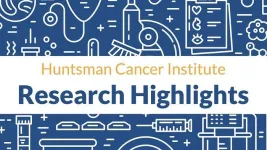(Press-News.org)
The chemical industry took a page out of the tobacco playbook when they discovered and suppressed their knowledge of health harms caused by exposure to PFAS (per- and polyfluoroalkyl substances), according to an analysis of previously secret industry documents by UC San Francisco (UCSF) researchers.
A new paper published May 31, 2023, in Annals of Global Health, examines documents from DuPont and 3M, the largest manufacturers of PFAS, and analyzes the tactics industry used to delay public awareness of PFAS toxicity and, in turn, delay regulations governing their use. PFAS are widely used chemicals in clothing, household goods, and food products, and are highly resistant to breaking down, giving them the name “forever chemicals.” They are now ubiquitous in people and the environment.
“These documents reveal clear evidence that the chemical industry knew about the dangers of PFAS and failed to let the public, regulators, and even their own employees know the risks,” said Tracey J. Woodruff, PhD, professor and director of the UCSF Program on Reproductive Health and the Environment (PRHE), a former senior scientist and policy advisor at the Environmental Protection Agency (EPA), and senior author of the paper.
This is the first time these PFAS industry documents have been analyzed by scientists using methods designed to expose tobacco industry tactics.
Adverse Effects Had Been Known for Decades
The secret industry documents were discovered in a lawsuit filed by attorney Robert Bilott, who was the first to successfully sue DuPont for PFAS contamination and whose story was featured in the film, “Dark Waters.” Bilott gave the documents, which span 45 years from 1961 to 2006, to producers of the documentary, “The Devil We Know,” who donated them to the UCSF Chemical Industry Documents Library.
“Having access to these documents allows us to see what the manufacturers knew and when, but also how polluting industries keep critical public health information private,” said first author Nadia Gaber, MD, PhD, who led the research as a PRHE fellow and is now an emergency medicine resident. “This research is important to inform policy and move us towards a precautionary rather than reactionary principle of chemical regulation.”
Little was publicly known about the toxicity of PFAS for the first 50 years of their use, the authors stated in the paper, The Devil They Knew: Chemical Documents Analysis of Industry Influence on PFAS Science, despite the fact that “industry had multiple studies showing adverse health effects at least 21 years before they were reported in public findings.”
The paper states that, “DuPont had evidence of PFAS toxicity from internal animal and occupational studies that they did not publish in the scientific literature and failed to report their findings to EPA as required under TSCA. These documents were all marked as ‘confidential,’ and in some cases, industry executives are explicit that they ‘wanted this memo destroyed.’”
Suppressing Information to Protect a Product
The paper documents a timeline of what industry knew versus public knowledge and analyzes strategies the chemical industry used to suppress information or protect their harmful products. Examples include:
As early as 1961, according to a company report, Teflon’s Chief of Toxicology discovered that Teflon materials had “the ability to increase the size of the liver of rats at low doses,” and advised that the chemicals “be handled ‘with extreme care’ and that ‘contact with the skin should be strictly avoided.’”
According to a 1970 internal memo, DuPont-funded Haskell Laboratory found C8 (one of thousands of PFAS) to be “highly toxic when inhaled and moderately toxic when ingested.” And in a 1979 private report for DuPont, Haskell labs found that dogs who were exposed to a single dose of PFOA “died two days after ingestion.”
In 1980, DuPont and 3M learned that two of eight pregnant employees who had worked in C8 manufacturing gave birth to children with birth defects. The company did not publish the discovery or tell employees about it, and the following year an internal memo stated, “We know of no evidence of birth defects caused by C-8 at DuPont.”
Despite these and more examples, DuPont reassured its employees in 1980 that C8, “has a lower toxicity, like table salt.” Referring to reports of PFAS groundwater contamination near one of DuPont’s manufacturing plants, a 1991 press release claimed, “C-8 has no known toxic or ill health effects in humans at concentration levels detected.”
As media attention to PFAS contamination increased following lawsuits in 1998 and 2002, DuPont emailed the EPA asking, “We need EPA to quickly (like first thing tomorrow) say the following: That consumer products sold under the Teflon brand are safe and to date there are no human health effects known to be caused by PFOA.”
In 2004, the EPA fined DuPont for not disclosing their findings on PFOA. The $16.45 million settlement was the largest civil penalty obtained under U.S. environmental statutes at the time. But it was still just a small fraction of DuPont’s $1 billion annual revenues from PFOA and C8 in 2005.
“As many countries pursue legal and legislative action to curb PFAS production, we hope they are aided by the timeline of evidence presented in this paper,” said Woodruff. “This timeline reveals serious failures in the way the U.S. currently regulates harmful chemicals.”
About UCSF: The University of California, San Francisco (UCSF) is exclusively focused on the health sciences and is dedicated to promoting health worldwide through advanced biomedical research, graduate-level education in the life sciences and health professions, and excellence in patient care. UCSF Health, which serves as UCSF's primary academic medical center, includes top-ranked specialty hospitals and other clinical programs, and has affiliations throughout the Bay Area. UCSF School of Medicine also has a regional campus in Fresno. Learn more at https://ucsf.edu, or see our Fact Sheet.
###
Follow UCSF
ucsf.edu | Facebook.com/ucsf | YouTube.com/ucsf
END
Makers of PFAS ‘forever chemicals’ covered up the dangers
Widely used in clothing, household products and food, they resist breaking down in the environment
2023-06-01
ELSE PRESS RELEASES FROM THIS DATE:
Antipsychotic drugs use increased in Canadian long-term care homes in first year of pandemic
2023-06-01
While most aspects of care quality in long-term care homes did not differ in the first year of the pandemic from pre-pandemic levels, a new study shows that the use of antipsychotic drugs increased in all provinces.
The study analyzed health system performance reports provided by the Canadian Institute for Health Information (CIHI) over three years: two before the pandemic and the first year of COVID-19. The reports are based on more than half a million resident assessments completed in Ontario, Manitoba, Alberta and British Columbia.
Researchers ...
Northsiders are more connected to nature than southsiders: study
2023-06-01
New research into Melburnians’ connection to nature is helping the City of Melbourne understand how to engage its community members in conservation efforts.
The study, led by RMIT University in collaboration with the City of Melbourne and Queensland University of Technology, surveyed over 1,500 City of Melbourne residents and visitors on their connection to nature and found nearly 75% of respondents had a high connection to nature.
More than 75% of respondents said they were concerned about climate change and the destruction of nature.
However, retirees and university students who have lived most of their lives in the Melbourne ...
Preventing truck crashes needs to take ‘dashcam’ approach to driver ‘microsleeps’
2023-06-01
Researchers using dashcam footage of real-world collisions involving large trucks to analyze driver and vehicle behavior has found that anti-drowsiness alarms or similar technologies to prevent falling asleep at the wheel need to go beyond a focus on monitoring the drivers’ eyes, and consider other microsleep behaviors including a relaxation of back and neck muscles and abnormal activity of the vehicle itself.
A study reporting the researchers’ findings was published April 13 in the ...
Improving immune checkpoint inhibitors’ anti-tumor response and minimizing side effects
2023-06-01
Scientists at Tohoku University have discovered a novel approach that improves the efficacy of immune checkpoint blockade (ICB) - a novel form of cancer treatment utilizing immune checkpoint inhibitors (ICIs) - and minimizes the associated side effects. They demonstrated that using ICIs to target tumor-positive lymph nodes generates a robust anti-tumor response against both local and systemic metastases.
The study was published in the Journal of Experimental and Clinical Cancer Research on June 1, 2023.
Our immune system uses “checkpoint proteins” to regulate and control the activity of immune cells. But cancer ...
Taxane-induced peripheral neuropathy in breast cancer: Frequent, clinically significant, and worse with paclitaxel
2023-06-01
Chemotherapy-induced peripheral neuropathy (CIPN) – nerve pain, tingling, or numbness in the hands or feet – is a common side effect of certain cancer treatments, including two drugs frequently used to treat cancer – the taxanes paclitaxel and docetaxel. Initial results from a large study that tracked CIPN in more than 1,100 patients treated for breast cancer with a taxane show a pattern of clinically meaningful, persistent sensory and motor symptoms, with patients experiencing more severe symptoms with paclitaxel than with docetaxel.
These initial results from the SWOG S1714 clinical trial are being reported in an oral presentation at the 2023 annual ...
DOE announces $46 million for commercial fusion energy development
2023-06-01
WASHINGTON, D.C.—The U.S. Department of Energy (DOE) today announced $46 million in funding to eight companies advancing designs and research and development for fusion power plants, representing a major step in President Biden’s commitment to a pilot-scale demonstration of fusion within a decade. Fusion reactions power the stars, and research is underway to make fusion energy production on Earth possible, providing an abundant, inherently safe, non-carbon-emitting energy source for the planet. This funding from the Milestone-Based ...
More than 1 in 6 unvaccinated people report health effects of COVID two years after confirmed infection
2023-06-01
Around 1 in 6 unvaccinated individuals say they are still experiencing health effects of covid-19 up to two years after infection, finds a study from Switzerland published by The BMJ today.
The findings show that 17% of participants did not return to normal health and 18% reported covid-19 related symptoms 24 months after initial infection.
Most people who have covid-19 recover soon after the initial phase of the disease, but others experience persistent health problems (known as long covid), which can impact quality of life ...
Improving emergency, critical and operative care in low and middle-income countries
2023-06-01
DALLAS and GENEVA, May 31, 2023 — Global efforts to improve emergency, critical and operative care for universal health coverage and protection from health emergencies were announced at the 76th World Health Assembly in Geneva, Switzerland. With the support of its partners the American Heart Association and the Laerdal Foundation, the World Health Organization (WHO), announced an initiative based on a new acute care resolution that was approved at this year’s World Health Assembly, the decision-making body of WHO.
Nearly 30 million deaths are due to emergency conditions each year, contributing to half of global deaths. The acute ...
Huntsman Cancer Institute May research highlights
2023-06-01
Huntsman Cancer Institute research highlights shine the spotlight on new discoveries and cutting-edge cancer research. This past month, researchers found a better treatment practice for patients who have melanoma. They also created a model for adrenocortical carcinoma, a rare cancer that originates in the outer portion of the adrenal gland. Learn more about a new brain cancer medication being fast-tracked for FDA approval and how Huntsman Cancer Institute was selected to conduct clinical trials for cancer patients with HIV.
Clinical trial suggests changes to melanoma patient care
A study recounting a clinical trial published ...
Postdoctoral research experience gets major boost at Pennington Biomedical
2023-06-01
Former Pennington Biomedical Research Center Executive Director Dr. Claude Bouchard and his wife, Monique Chagnon, were celebrated at a luncheon on Tuesday, May 30, for their generous gift to enhance the postdoctoral researcher experience at Pennington Biomedical.
As one of the world’s foremost researchers in the genetics of obesity and related diseases, including type 2 diabetes and hypertension, the Bouchard laboratory has trained about 40 postdoctoral researchers throughout his career.
“I became very conscious that postdocs are critical to the success of the scientific research enterprise. They work hard, they ...
LAST 30 PRESS RELEASES:
Why nail-biting, procrastination and other self-sabotaging behaviors are rooted in survival instincts
Regional variations in mechanical properties of porcine leptomeninges
Artificial empathy in therapy and healthcare: advancements in interpersonal interaction technologies
Why some brains switch gears more efficiently than others
UVA’s Jundong Li wins ICDM’S 2025 Tao Li Award for data mining, machine learning
UVA’s low-power, high-performance computer power player Mircea Stan earns National Academy of Inventors fellowship
Not playing by the rules: USU researcher explores filamentous algae dynamics in rivers
Do our body clocks influence our risk of dementia?
Anthropologists offer new evidence of bipedalism in long-debated fossil discovery
Safer receipt paper from wood
Dosage-sensitive genes suggest no whole-genome duplications in ancestral angiosperm
First ancient human herpesvirus genomes document their deep history with humans
Why Some Bacteria Survive Antibiotics and How to Stop Them - New study reveals that bacteria can survive antibiotic treatment through two fundamentally different “shutdown modes”
UCLA study links scar healing to dangerous placenta condition
CHANGE-seq-BE finds off-target changes in the genome from base editors
The Journal of Nuclear Medicine Ahead-of-Print Tip Sheet: January 2, 2026
Delayed or absent first dose of measles, mumps, and rubella vaccination
Trends in US preterm birth rates by household income and race and ethnicity
Study identifies potential biomarker linked to progression and brain inflammation in multiple sclerosis
Many mothers in Norway do not show up for postnatal check-ups
Researchers want to find out why quick clay is so unstable
Superradiant spins show teamwork at the quantum scale
Cleveland Clinic Research links tumor bacteria to immunotherapy resistance in head and neck cancer
First Editorial of 2026: Resisting AI slop
Joint ground- and space-based observations reveal Saturn-mass rogue planet
Inheritable genetic variant offers protection against blood cancer risk and progression
Pigs settled Pacific islands alongside early human voyagers
A Coral reef’s daily pulse reshapes microbes in surrounding waters
EAST Tokamak experiments exceed plasma density limit, offering new approach to fusion ignition
Groundbreaking discovery reveals Africa’s oldest cremation pyre and complex ritual practices
[Press-News.org] Makers of PFAS ‘forever chemicals’ covered up the dangersWidely used in clothing, household products and food, they resist breaking down in the environment


